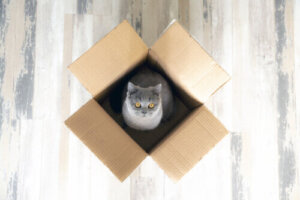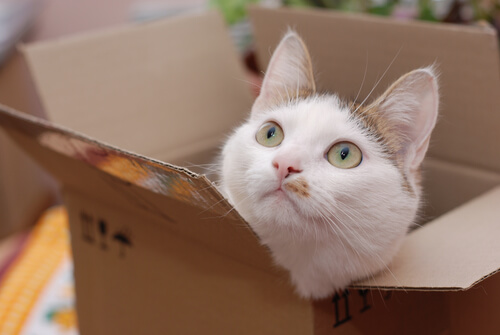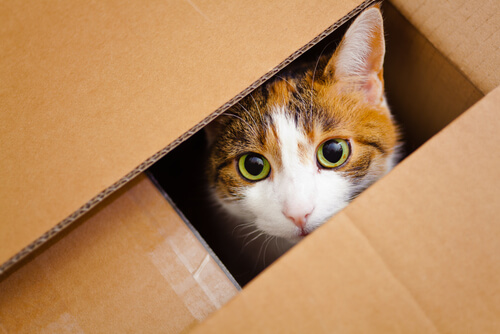Why Do Cats Love Boxes?


Written and verified by the biologist Georgelin Espinoza Medina
Cats are adorable animals, albeit independent, territorial, and routine lovers. If you have one at home, you have surely noticed a predilection for certain objects such as boxes, since they love to crawl into them to sleep or explore the world around them. Why is this? Why do cats love boxes so much?
Felines love to play and explore. They also have very strong intuitive behavior and like to take a look at any packages you bring into the home. The same happens with cardboard boxes. If you’re concerned about this behavior, you’ve come to the right place, because in this article we’ll show you the reasons why cats love boxes so much. Don’t miss it!
Cats love boxes because they provide shelter

Cats are intuitive animals and very good hunters. To catch their prey, they stay alert to what’s happening around them, make stealthy and quick movements, and perform a perfect ambush. The victim can’t escape, trapped by their claws and teeth.
This is why cats need places to hide. Places that give them an adequate field of vision where they can be aware of what’s going on around them. They also need hiding places to hide from threats. In this sense, boxes are perfect, because they’re comfortable environments and appropriate shelters.
Cats love boxes because they provide them with security, offering them an ideal area to help them to be alert to what’s going on around them. At the same time, they give them protection.
Research in Canada, published in the 2017 journal Behavioural Processes, recounts the value of boxes as places of shelter for kittens. The study looked at 26 shelter cats with different environmental enrichment options to choose from. The preferred alternative was the hiding box, as opposed to toys or perching spaces.
Boxes provide warmth for cats
In addition to providing security, boxes protect cats from the cold, because they provide insulation from external heat. This is why cats find in them warm environments to rest and shelter. In short, everything they need for their well-being in one place, which is why they can’t resist spending their time inside these objects.
Boxes reduce stress in cats
Thanks to all the properties of boxes that have been mentioned in the previous paragraphs, these felines find in them a perfect calming of their anxiety, fear, or stress. Thus, the organization The People’s Dispensary for Sick Animals recommends their use to give cats a bit of entertainment.
A study published in the journal Applied Animal Behaviour Science in 2014 evaluated the effect of hide-and-seek boxes on stress levels in cats. In particular, in 19 kittens recently arrived at a shelter in the Netherlands. It revealed that the animals that were given the boxes to enrich their environment, adapted faster to their new surroundings., as opposed to the cats that didn’t have these objects.
Remember that cats are routine animals, so a new home (with or without other animals) represents a situation that is out of the ordinary. In this way, the boxes generate well-being. At the same time, they can help them effectively cope with the stressful elements around them. In this case, the new environment.
Another more recent study, from 2019 and published in the journal Plos One, also relates to the effect of hiding boxes on newly arrived cats in a Dutch shelter. In this case, 23 animals participated, which were also assessed for body weight during the first 12 days of their stay. The results indicate that the presence of the boxes reduced stress in the kittens. However, they didn’t offer protection against weight loss.
It’s estimated that reducing stress levels in cats may have an overall impact on their well-being. These benefits may also lead to a lower incidence of certain infectious diseases. However, more research related to these aspects is needed.
Other benefits of boxes

In addition to the above, boxes also provide an item for cats to chew or scratch. In this way, they offer a space of their own that they can mark with their pheromones.
They’re also inexpensive, easy to obtain, and can even be decorated to personalize them for your cat. A simple option that makes your pet happy.
Now you know all the reasons why cats love boxes. More than simple objects, they represent very comfortable, safe, and warm spaces that help them to be calm and happy. Just remember to check that there are no staples, plastic, or any other material that could cause them any harm.
Cats are adorable animals, albeit independent, territorial, and routine lovers. If you have one at home, you have surely noticed a predilection for certain objects such as boxes, since they love to crawl into them to sleep or explore the world around them. Why is this? Why do cats love boxes so much?
Felines love to play and explore. They also have very strong intuitive behavior and like to take a look at any packages you bring into the home. The same happens with cardboard boxes. If you’re concerned about this behavior, you’ve come to the right place, because in this article we’ll show you the reasons why cats love boxes so much. Don’t miss it!
Cats love boxes because they provide shelter

Cats are intuitive animals and very good hunters. To catch their prey, they stay alert to what’s happening around them, make stealthy and quick movements, and perform a perfect ambush. The victim can’t escape, trapped by their claws and teeth.
This is why cats need places to hide. Places that give them an adequate field of vision where they can be aware of what’s going on around them. They also need hiding places to hide from threats. In this sense, boxes are perfect, because they’re comfortable environments and appropriate shelters.
Cats love boxes because they provide them with security, offering them an ideal area to help them to be alert to what’s going on around them. At the same time, they give them protection.
Research in Canada, published in the 2017 journal Behavioural Processes, recounts the value of boxes as places of shelter for kittens. The study looked at 26 shelter cats with different environmental enrichment options to choose from. The preferred alternative was the hiding box, as opposed to toys or perching spaces.
Boxes provide warmth for cats
In addition to providing security, boxes protect cats from the cold, because they provide insulation from external heat. This is why cats find in them warm environments to rest and shelter. In short, everything they need for their well-being in one place, which is why they can’t resist spending their time inside these objects.
Boxes reduce stress in cats
Thanks to all the properties of boxes that have been mentioned in the previous paragraphs, these felines find in them a perfect calming of their anxiety, fear, or stress. Thus, the organization The People’s Dispensary for Sick Animals recommends their use to give cats a bit of entertainment.
A study published in the journal Applied Animal Behaviour Science in 2014 evaluated the effect of hide-and-seek boxes on stress levels in cats. In particular, in 19 kittens recently arrived at a shelter in the Netherlands. It revealed that the animals that were given the boxes to enrich their environment, adapted faster to their new surroundings., as opposed to the cats that didn’t have these objects.
Remember that cats are routine animals, so a new home (with or without other animals) represents a situation that is out of the ordinary. In this way, the boxes generate well-being. At the same time, they can help them effectively cope with the stressful elements around them. In this case, the new environment.
Another more recent study, from 2019 and published in the journal Plos One, also relates to the effect of hiding boxes on newly arrived cats in a Dutch shelter. In this case, 23 animals participated, which were also assessed for body weight during the first 12 days of their stay. The results indicate that the presence of the boxes reduced stress in the kittens. However, they didn’t offer protection against weight loss.
It’s estimated that reducing stress levels in cats may have an overall impact on their well-being. These benefits may also lead to a lower incidence of certain infectious diseases. However, more research related to these aspects is needed.
Other benefits of boxes

In addition to the above, boxes also provide an item for cats to chew or scratch. In this way, they offer a space of their own that they can mark with their pheromones.
They’re also inexpensive, easy to obtain, and can even be decorated to personalize them for your cat. A simple option that makes your pet happy.
Now you know all the reasons why cats love boxes. More than simple objects, they represent very comfortable, safe, and warm spaces that help them to be calm and happy. Just remember to check that there are no staples, plastic, or any other material that could cause them any harm.
All cited sources were thoroughly reviewed by our team to ensure their quality, reliability, currency, and validity. The bibliography of this article was considered reliable and of academic or scientific accuracy.
- Ellis, J., Stryhn, H., & Cockram, M. (2021). Effects of the provision of a hiding box or shelf on the behaviour and faecal glucocorticoid metabolites of bold and shy cats housed in single cages. Applied Animal Behaviour Science, 236, 105221. https://www.sciencedirect.com/science/article/abs/pii/S0168159121000083
- Ellis, J., Stryhn, H., Spears, J., Cockram, M. (2017). Environmental enrichment choices of shelter cats. Behavioural Processes, 141, 291-296. https://www.sciencedirect.com/science/article/abs/pii/S0376635716302984
- The People´s Dispensary for Sick Animals. (s.f.). How to create a cat-friendly home. Consultado el 03 de abril de 2023. https://www.pdsa.org.uk/pet-help-and-advice/looking-after-your-pet/kittens-cats/ideal-environment-for-cats
- Van der Leij, W., Selman, L., Vernooij, J., & Vinke, C. (2019). The effect of a hiding box on stress levels and body weight in Dutch shelter cats; a randomized controlled trial. PLOS ONE, 14(10), e0223492. https://journals.plos.org/plosone/article?id=10.1371/journal.pone.0223492
- Vinke, C., Godijn, L., & van der Leij, W. (2014). Will a hiding box provide stress reduction for shelter cats? Applied Animal Behaviour Science, 160, 86-93. https://www.sciencedirect.com/science/article/abs/pii/S0168159114002366
This text is provided for informational purposes only and does not replace consultation with a professional. If in doubt, consult your specialist.








